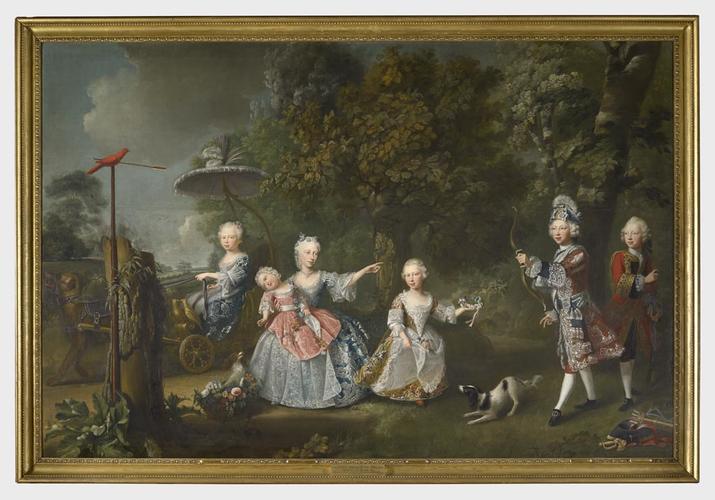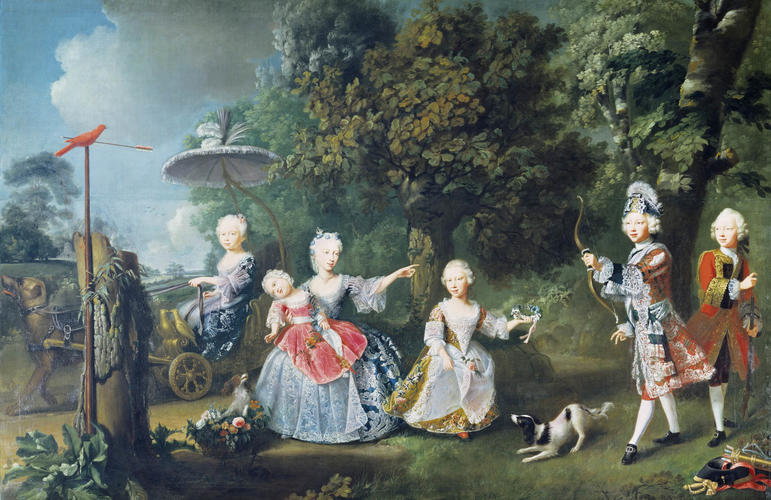-
1 of 253523 objects
The Children of Frederick and Augusta, Prince and Princess of Wales 1746
Oil on canvas | 245.0 x 368.8 cm (support, canvas/panel/stretcher external) | RCIN 403400

Barthélemy du Pan (1712-63)
Frame for RCIN 403400, Du Pan, The Children of Fredrick, Prince of Wales 1746


-
Du Pan was a Swiss portrait painter who came to England in 1743, perhaps planning to replace Jean-Baptiste Vanloo (1684-1745), an artist of similar elegantly French style who left England in 1742. Both artists worked for the Prince of Wales.
This group portrait of 1746 depicts the six eldest children of Frederick, Prince of Wales, playing in a landscape which appears to be at the margin between farmed land, woodland and an informal 'English-style' park, with a Temple structure visible in the left background. The setting has been plausibly identified as Park Place, the country house acquired by Frederick in 1738, but it could equally be a generic evocation of the fashionable outdoors. It has been suggested that the temple is one designed by William Kent in 1734 for the garden of Carlton House.
The children are playing with vigour and spirit: on the right Prince George (future George III) has just loosed an arrow which has struck the popinjay; Prince Edward is loading his flintlock, but the prize already belongs to his brother. Princess Augusta, holding the baby Prince Henry, points to the winner and Prince William (still young enough to be in skirts) holds out his wreath of victory. To the left Princess Elizabeth drives a pretty carriage drawn by dogs and decorated with billing doves, which suggests that it is dedicated to Venus, the Goddess of Love. The boys are sporty; the girls loving, lovely and maternal; dogs join in the play and the sun shines.
Nothing in this scene would surprise in a small conversation piece by Zoffany of the 1760s; this painting however is on the scale of life and therefore huge and dates from a decade before Zoffany's arrival in England. It reminds us that the belief in the benefit for children of exercise, fresh air and freedom predate Jean-Jacques Rousseau. In this case it is of course especially significant that the winner of this pastoral competition is a wholesome, fraternal, freedom-loving, future King.
The inclusion of tartan (worn by Prince George) in a painting executed within months of the Battle of Culloden excited comment even at the time. In fact this is the uniform of the Royal Company of Archers, which had been fixed as early as 1713 and included the Stuart tartan; like all British regimental tartan this escaped the ban on Scottish national dress which followed the Rebellion of 1745. Indeed it is probably that this painting is a part of the process of assimilating Scottish identity as something manly and romantic, rather than threatening and rebellious.
Du Pan was paid £100 for this painting in 1747 and painted two copies for £75 each. This one was seen by Horace Walpole in 1761 at Kew, in the Dressing Room of the sitters' mother, Princess Augusta; the copies have vanished without trace. The huge size of the work suggests that it was originally intended for a great hall or drawing room; it may be connected with du Pan's two full-length portraits of the children's parents, Frederick and Augusta, Prince and Princess of Wales of c.1745 in the Ulster Museum.Provenance
Painted for Frederick, Prince of Wales; in Princess Augusta's Dressing Room at Kew Palace in 1761; in the Cube Room at Kensington Palace in 1818 (no 397)
-
Creator(s)
Commissioner(s)
Subject(s)
-
Medium and techniques
Oil on canvas
Measurements
245.0 x 368.8 cm (support, canvas/panel/stretcher external)
269.3 x 395.3 x 10.0 cm (frame, external)
Category
Object type(s)
Subject(s)
Other number(s)
Alternative title(s)
The Children of Frederick, Prince of Wales
The six Eldest Children of Frederick, Prince of Wales